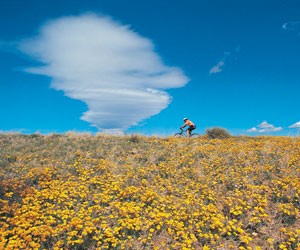Encompassing more than 267,000 square miles, Texas truly is larger than life. Drive its latitudes and longitudes and you will know: Interstate 10 East’s Exit 880 near Orange, Texas, is the highest numbered exit in the interstate system. Several geosystems—the Great Plains, the Gulf Coast and the Rocky Mountains—converge within its boundaries, producing a microcosmic American terrain that includes more surface water acreage than Minnesota. From the gaping gulf of Palo Duro Canyon to the shimmering waters of the Gulf, Texas is a field day of natural engagements.
Coasting Along
Stretching 624 sandy miles from Cajun-influenced Beaumont to southernmost Brownsville, the Texas Gulf Coast, in rapid post-hurricane recovery mode, is enjoying a visitor surge from staycationing Texans discovering their own big backyard beach.
Flirting with the southerly edges of the forested Piney Woods region in East Texas, Beaumont is within reach of the spectacular Big Thicket National Preserve, while nearby Orange is home to the wondrous Shangri La Botancial Gardens and Nature Center. A green phoenix arisen, this 252-acre Eden shook off decades of neglect to become one of the world’s most Earth-friendly projects.
South of historic resort haven Galveston Island and its 32 miles of sun-drenched sand, beachside relaxation meets big-city convenience in Corpus Christi. Complementing a range of meetings-ready hotels and large-scale venues are unique spaces such as the heroic USS Lexington Museum by the Bay, the Texas State Aquarium and the new Yachting Center, with a variety of options for gatherings. At-leisure pursuits include horseback riding on the beach, golfing on waterfront courses and boat tours of Corpus Christi Bay.
In nearby Rockport-Fulton, wildlife tours are available at the 115,000-acre Aransas National Wildlife Refuge.
Stretching 34 miles, South Padre Island is the world’s longest barrier island. Connected to the mainland by a half-mile-long causeway, this tropical slice of land, while a natural magnet for sun worshippers of all stripes and ages, is also a major ecotourism destination. With a 45,000-square-foot convention center as the main base, conferees can take dolphin boat tours, go bird-watching or view the rescue and rehabilitation efforts of Sea Turtle Inc. Sailing and windsurfing are also popular outdoor diversions for South Padre Island visitors.
Flights of Fancy
Mass squadrons of migratory birds—and the human enthusiasts who watch them—have a Texas-size mecca in South Texas, a major draw for its warm tropical climes.
For British bird-tour leader and author Neil Glenn, who follows his feathered friends around the globe, the region is a top spot for bird watchers.
"The Lower Rio Grande Valley, with its vast species of birds and butterflies, deservedly is high on every world birder’s list of must-see places," he says.
McAllen, the City of Palms (and wildly chattering parakeets), sits at the epicenter of this avian wonderland, surrounded by wildlife and birding sanctuaries. The Santa Ana National Wildlife Refuge, for one, has one of the most diverse bird populations in the U.S., while the large adobe mansion at Quinta Mazatlan, the McAllen wing of the World Birding Center, is a favorite place for conferences and receptions.
The city is also home to the 150-acre Rancho El Charco wildlife park, one of the last surviving patches of brush country in South Texas. Bordered by a 75-acre lake and featuring a nature center, the park is an enchanting choice for meetings.
Bird watchers and wildlife enthusiasts also flock to Brownsville, which stages the annual Brownsville International Birding and Nature Festival, held in February. The city also features premier attractions such as the 26-acre Gladys Porter Zoo and Sabal Palm Audubon Center.
Far And Away
Solitary as it is scenic, the far reaches of West Texas remain a spellbinding tableau of the Old West. For many, this is the Texas of the imagination, a dreamscape of mountains and mesas endlessly running with desert sands and restless with the spirits of conquistadors, pioneers, bandits, cowboys and Native Americans.
Exemplifying the region’s vastness, Big Bend National Park consumes the state’s entire southwestern tip. In the state’s westernmost corner, El Paso has stood sentinel for four centuries. More ancient by far are the prehistoric pictographs decorating the walls of the nearby 860-acre Hueco Tanks State Historic Site, believed to date to 1,500 B.C. El Paso also offers a natural outdoor venue in the McKelligon Canyon Amphitheatre, soaring cable car rides aboard the Wyler Aerial Tramway and expansive, picturesque terrain for outdoor adventures such as hiking and biking.
Always the star of the party is the McDonald Observatory in high-altitude Fort Davis, where stargazers gather for public and private events around one the world’s most powerful telescopes.
Deeper in the heart of Big Bend Country, Odessa features the second-largest meteor crater in the U.S.







